|
|
Pico-Ion PPB Oxygen Sensors
UHP Version | MS
Version |
PDF
|
| The
Pico-Ion PPB oxygen sensor and
electrochemical oxygen purity sensor
represent the only real innovations
electrochemical sensor technology in
decades.
 Quality,
a critical element of customer satisfaction,
is taken very seriously at Analytical
Industries Inc. All products are
manufactured under an independently
certified Quality System that complies with
ISO 9001:2008,
MDD/93/42 EEC (European CE),
ISO 13485:2003 (Health Canada) and
FDA regulatory standards. To further
ensure the confidence of our global customer
base, analyzers designed for use in
hazardous areas are independently
ATEX and/or UL (pending) certified. Quality,
a critical element of customer satisfaction,
is taken very seriously at Analytical
Industries Inc. All products are
manufactured under an independently
certified Quality System that complies with
ISO 9001:2008,
MDD/93/42 EEC (European CE),
ISO 13485:2003 (Health Canada) and
FDA regulatory standards. To further
ensure the confidence of our global customer
base, analyzers designed for use in
hazardous areas are independently
ATEX and/or UL (pending) certified. |
Pico-Ion UHP PPB Oxygen Sensor
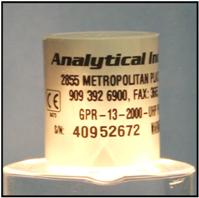
The unique features of this breakthrough
in sensor technology are a proprietary
sensing electrode material and a gas chamber
design that maximizes the rate of reaction
above the sensing electrode while minimizing
both the amount of oxygen that dissolves
into the electrolyte and the temperature
dependence of the sensor’s output, thereby
ensuring long-term stability. This compact
self contained package requires no
maintenance or periodic addition of
chemicals and is easily replaced at the end
of its 15 month service life. The
capabilities of the resulting sensor are:
| Accuracy: |
+1% FS under
constant conditions |
| Sensitivity: |
<0.5 PPB |
| Noise level: |
<0.2 PPB |
| Stability: |
<1 ppb over temperature
fluctuations of +10ºF |
| Low range: |
0-100 PPB full scale |
| Response time: |
90% of full scale in <60 seconds
|
| Recovery to: |
10 PPB from 1 minute exposure to
9 PPM in 15 minutes
1 PPB from 1 minute exposure to 9
PPM in 60 minutes
1 PPB from 5 minute exposure to 1
PPM in 30 minutes |
| Expected life: |
15 months in normal applications |
Pico-Ion MS PPB Oxygen Sensor
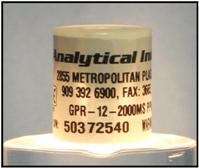
Drawing upon the features of the UHP
sensor, the MS sensor provides the signal
output and stability required for oxygen
analysis above 5 PPB to fill a much needed
cost effective solution between expensive
sub-PPB sensors and the limitations of
historical galvanic trace PPM sensors.
| Accuracy: |
+1% FS under
constant conditions |
| Sensitivity: |
<5 PPB |
| Noise level: |
<2 PPB |
| Stability: |
<10 ppb over temperature
fluctuations of +10ºF |
| Low range: |
0-1 PPM full scale |
| Response time: |
90% of full scale in <20 seconds
|
| Recovery to: |
1 PPM from 30 second exposure to
air in 45 minutes
10 PPB from 5 minute exposure to 1
PPM in 15 minutes
10 PPB from 2 minute exposure to 9
PPM in 10 minutes |
| Expected life: |
24-36 months in normal
applications |
|
Galvanic Trace PPM Oxygen Sensors
0-10 PPM Version |
0-100 PPM Version |
PDF
|
| The
Pico-Ion PPB oxygen sensor and
electrochemical oxygen purity sensor
represent the only real innovations
electrochemical sensor technology in
decades. Applying this advanced technology
to traditional sensors produced a new
generation of trace PPM and percent sensors
that can be readily applied to a wide range
of applications in the industrial process
control, natural gas, medical, diving and
personnel safety markets.
 Quality,
a critical element of customer satisfaction,
is taken very seriously at Analytical
Industries Inc. All products are
manufactured under an independently
certified Quality System that complies with
ISO 9001:2008,
MDD/93/42 EEC (European CE),
ISO 13485:2003 (Health Canada) and
FDA regulatory standards. To further
ensure the confidence of our global customer
base, analyzers designed for use in
hazardous areas are independently
ATEX and/or UL (pending) certified. Quality,
a critical element of customer satisfaction,
is taken very seriously at Analytical
Industries Inc. All products are
manufactured under an independently
certified Quality System that complies with
ISO 9001:2008,
MDD/93/42 EEC (European CE),
ISO 13485:2003 (Health Canada) and
FDA regulatory standards. To further
ensure the confidence of our global customer
base, analyzers designed for use in
hazardous areas are independently
ATEX and/or UL (pending) certified. |
Galvanic 0-10 Trace PPM Oxygen Sensor
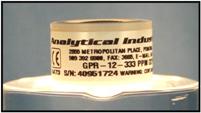
Exhibit superior stability at low PPM
oxygen levels, faster recovery from
excursions to high oxygen concentrations and
a longer service life than traditional
sensors.
A proprietary electrolyte that
demonstrates excellent compatibility with up
to 100% concentrations of carbon dioxide
(CO2) has made the XLT sensors the standard
for measuring oxygen contamination in
beverage grade CO2 and natural gas. Required
for continuous exposure to CO2 levels 0.5%,
the XLT sensors also feature an extended
operating temperature range of -20°C.
| Accuracy: |
+1% FS under
constant conditions |
| Sensitivity: |
<50 PPB |
| Low range: |
0-10 PPM full scale |
| Response time: |
90% of full scale in <7 seconds |
| Expected life: |
24-36 months in normal
applications |
| Recovery to: |
see illustration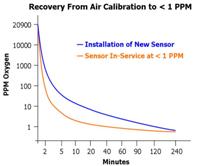 |
Galvanic 0-100 PPM Oxygen Sensor
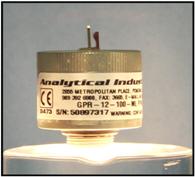
The 0-100 PPM sensor carries over many of
the features of the more sensitive sensor
and was developed to provide a cost
effective analyzer solution for higher level
PPM oxygen analysis.
| Accuracy: |
+1% FS under
constant conditions |
| Sensitivity: |
<500 PPB |
| Low range: |
0-100 PPM full scale |
| Response time: |
90% of full scale in <13 seconds
|
| Recovery to: |
50 PPM from air
calibration in 45 minutes
|
| Expected life: |
24-36 months in normal
applications |
|
Galvanic Percent Oxygen Sensors
0-1% Range |
Generic |
PDF
|
|
Applying this advanced technology derived
from the Pico-Ion and electrochemical oxygen
purity innovations to traditional sensors
produced a new generation of percent sensors
that can be readily applied to a wide range
of applications in the industrial process
control, natural gas, medical, diving and
personnel safety markets.
 Quality,
a critical element of customer satisfaction,
is taken very seriously at Analytical
Industries Inc. All products are
manufactured under an independently
certified Quality System that complies with
ISO 9001:2008,
MDD/93/42 EEC (European CE),
ISO 13485:2003 (Health Canada) and
FDA regulatory standards. To further
ensure the confidence of our global customer
base, analyzers designed for use in
hazardous areas are independently
ATEX and/or UL (pending) certified. Quality,
a critical element of customer satisfaction,
is taken very seriously at Analytical
Industries Inc. All products are
manufactured under an independently
certified Quality System that complies with
ISO 9001:2008,
MDD/93/42 EEC (European CE),
ISO 13485:2003 (Health Canada) and
FDA regulatory standards. To further
ensure the confidence of our global customer
base, analyzers designed for use in
hazardous areas are independently
ATEX and/or UL (pending) certified. |
Galvanic Oxygen Sensors for 0-1% Range
Most applications for percentage range
oxygen analysis emphasize the need for
longer life in order to minimize service
requirements. However, the transitioning
from high PPM to low percent oxygen analysis
area presents a grey area that adds
additional considerations.
The design of sensors for low level
measurements involves a delicate balance
between a higher
signal output
that improves stability by reducing the
influence of temperature and expected life.
The ability to recognize this issue and
offer a number of solutions, see chart
below, differentiates Analytical Industries
Inc. from our competitors and enables users
to select the best option for their
particular application.
| Sensor |
Output |
Response |
Stability |
Life |
| GPR-11-32 |
50 uA |
13 sec |
0.05% |
36 mos |
| XLT-11-24 |
50 uA |
13 sec |
0.05% |
24 mos |
| XLT-11-15 |
180 uA |
30 sec |
0.03% |
15 mos |
| XLT-11-1523 |
300 uA |
13 sec |
0.02% |
10 mos |
| XLT-11-1513 |
500 uA |
10 sec |
0.01% |
5 mos |
Galvanic Percent Oxygen Sensor
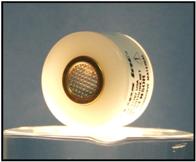
Exhibit superior performance,
reliability, extended life and extended
operating temperature range which are
critical to meeting the need for oxygen
measurements imposed by today’s industrial
process, medical, diving, natural gas,
safety and welding applications.
XLT sensors have an extended operating
temperature range of –20°, demonstrate
excellent compatibility with carbon dioxide
concentrations up to 100% and are required
for continuous exposure to carbon dioxide
levels above 0.5%.
| Accuracy: |
+1% FS under
constant conditions |
| Sensitivity: |
<0.5% of full scale range |
| Low range: |
0-1% full scale |
| Response time: |
90% of full scale in <13 seconds
|
|
Recovery to: |
0.1% from exposure
to air <30 seconds |
| Expected life: |
24-120 months in normal
applications |
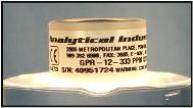
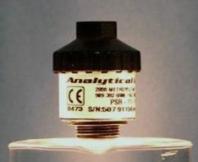
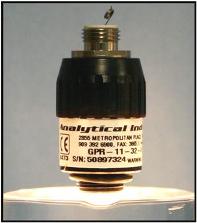
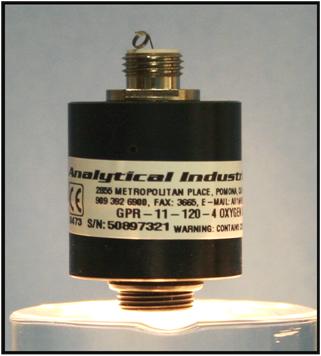
|
Galvanic Oxygen Purity Sensor
Background |
PDF
|
 Quality,
a critical element of customer satisfaction,
is taken very seriously at Analytical
Industries Inc. All products are
manufactured under an independently
certified Quality System that complies with
ISO 9001:2008,
MDD/93/42 EEC (European CE),
ISO 13485:2003 (Health Canada) and
FDA regulatory standards. To further
ensure the confidence of our global customer
base, analyzers designed for use in
hazardous areas are independently
ATEX and/or UL (pending) certified. Quality,
a critical element of customer satisfaction,
is taken very seriously at Analytical
Industries Inc. All products are
manufactured under an independently
certified Quality System that complies with
ISO 9001:2008,
MDD/93/42 EEC (European CE),
ISO 13485:2003 (Health Canada) and
FDA regulatory standards. To further
ensure the confidence of our global customer
base, analyzers designed for use in
hazardous areas are independently
ATEX and/or UL (pending) certified.
|

An innovative and cost effective solution
that provides 2 years of continuous
measurements of up to 100% oxygen
concentrations in a maximum suppressed range
of 90-100% full scale with minimum drift,
extended periods between calibration,
unaffected by vibration and minor amounts of
particulates and moisture.
| Accuracy: |
+1% FS under
constant conditions
Inherent 0.1% after calibration with
100% oxygen |
| Sensitivity: |
0.5% of full scale rane |
| High range: |
90-100% suppressed full scale
range |
| Response time: |
90% of full scale in <13 seconds
|
| Expected life: |
24 months at 100% oxygen levels |
|
Background
Historically, the production of pure oxygen
has been confined to medical grade oxygen
(99.0%). However, the demand for oxygen is
expanding rapidly due to developments in
chemical processes requiring elevated levels
of oxygen (85-95%) that boost yields and
reduce emissions without significant cost
increases. To a lesser extent the growth of
transfilling oxygen (92%) cylinders for home
care use. The oxygen supplied can be
produced cryogenically, by pressure (PSA) or
by vacuum (VSA) swing adsorption methods.
Analyzers based on paramagnetic sensors
have been the primary method of measuring
oxygen purity. These sensors offer highly
accurate results especially at the
suppressed ranges of 98-100% oxygen.
However, they are very sensitive to changes
in the flow rate of the sample gas, the
presence of minute particulates and
moisture, temperature variations and
vibration. As a result, compensating for
these characteristics is expensive and
requires frequent calibration of
paramagnetic oxygen analyzers.
Analyzers based on galvanic oxygen
sensors have always generated interest for
oxygen purity measurements because they are
specific to oxygen, versatile, low
maintenance and less expensive. However,
short sensor life and drift in the sensor’s
signal output with time have precluded their
use.
Major
Advancement in Galvanic Sensor Technology
An advanced galvanic sensor has been
developed that is capable of accurately
measuring 100% oxygen concentrations
continuously over a two (2) year period.
This proprietary design addresses the
challenges of: 1) providing a sufficient
amount of anode material to support the
reduction of oxygen over several years,
2) maintaining at all times a sufficient
concentration of hydroxyl ions to support
the reduction of oxygen at and near the
sensing electrode, and, 3) preventing the
build-up of PbO at and near the sensing
electrode that can cause the signal output
of the sensor to drop or drift with time.
Through proprietary means the production
rate of the reaction product is controlled
without sacrificing either the fast response
time (less than 13 seconds) or any of the
features (described above) of analyzers
based on galvanic sensors. The performance
of this proprietary sensor was confirmed
over 14 months of testing and exhibited
excellent stability in 100% oxygen.
Performance
Test Results
With the sensor and sample gas lines
temperature controlled and the signal output
of the sensor compensated fro ambient
pressure variations, it was possible to
measure oxygen in the suppressed range of
90-100% with less than +1% of full scale
(+0.1% oxygen) accuracy. The calibration was
checked periodically and found to be within
+1% of full scale over the 14 month test
period suggesting the interval between
calibrations could be extended to several
months.
To demonstrate the stability of the new
analyzer, 99.5% oxygen was introduced
(typically the threshold for manufacturers
of pure oxygen) for 30 days and the output
trended. The maximum variation in the signal
output is +0.1% oxygen over a 24 hour period
and is primarily attributed to the variation
in ambient temperature.
Based on the foregoing, the new analyzer
galvanic sensor based analyzer offers a very
viable and cost effective solution for
measuring elevated oxygen levels up to and
above 99.5% in a maximum suppressed range of
90-100% with excellent accuracy and
stability, a significant reduction in
calibration requirements, unaffected by
vibration and minor amounts of particulates
and moisture. |
美国AII氧分析仪传感器XLT-12-123 美国AII氧分析仪传感器PSR-12-22 美国AII氧分析仪传感器PSR-12-24
美国AII氧分析仪传感器PSR-12-223 美国AII氧分析仪传感器XLT-11-15 美国AII氧分析仪传感器PSR-11-21
美国AII氧分析仪传感器PSR-11-213 美国AII氧分析仪传感器PSR-11-23 美国AII氧分析仪传感器PSR-11-233
美国AII氧分析仪传感器PSR-11-25 美国AII氧分析仪传感器PSR-11-77 美国AII氧分析仪传感器PSR-11-54 美国AII氧分析仪传感器PSR-11-52
美国AII氧分析仪传感器PSR-11-39
| 产品图片 |
产品名称/型号 |
产品简单介绍 |
|
|
美国AII氧分析仪传感器XLT-12-123
美国AII XLT-12-123
|
|
|
|
美国AII氧分析仪传感器PSR-12-22
美国AII PSR-12-22
|
|
|
|
美国AII氧分析仪传感器PSR-12-223
美国AII PSR-12-223
|
|
|
|
美国AII氧分析仪传感器PSR-12-24
美国AII PSR-12-24
|
|
|
|
美国AII氧分析仪传感器XLT-11-15
美国AII XLT-11-15
|
|
|
|
美国AII氧分析仪传感器PSR-11-21
美国AII PSR-11-21
|
|
|
|
美国AII氧分析仪传感器PSR-11-213
美国AII PSR-11-213
|
|
|
|
美国AII氧分析仪传感器PSR-11-23
美国AII PSR-11-23
|
|
|
|
美国AII氧分析仪传感器PSR-11-233
美国AII PSR-11-233
|
|
|
|
美国AII氧分析仪传感器PSR-11-25
美国AII PSR-11-25
|
|
|
|
美国AII氧分析仪传感器PSR-11-77
美国AII PSR-11-77
|
|
|
|
美国AII氧分析仪传感器PSR-11-54
美国AII PSR-11-54
|
|
|
|
美国AII氧分析仪传感器PSR-11-52
美国AII PSR-11-52
|
|
|
|
美国AII氧分析仪传感器PSR-11-39
美国AII PSR-11-39
|
|
美国AII氧气传感器,GPR氧燃料电池,PSR氧电极,XLT氧电池
-
类 别: 分析仪器 > 气体检测仪 气体传感器
-
名 称: 美国AII氧气传感器,GPR氧燃料电池,PSR氧电极,XLT氧电池
-
型 号:
GPR-12-2000MS,GPR-12-333,GPR-11-32-4,PSR-12-223
-
品 牌: 美国先进AII/ADV公司
-
参考价格: 书面报价
美国AII(ADV)公司的氧气传感器(氧气传感器、氧电极、氧电池、氧燃料电池)制造技术使得近几十年来的电化学传感器技术实现了革命性的突破, 其将微燃料电池氧传感器的灵敏度提高到了1ppb,寿命长达2-10年,响应时间以及从工艺波动中恢复时间大大缩短,使用温度拓宽到了-30度,稳定性大为提高从而延长了标定周期。另外,AII美国AII(ADV)公司还提供一系列高质量替代传感器,可发和市场上主要厂商的电化学氧传感器互换使用。和市场上主要的氧仪表相比,提供了最好的性能价格比。在绝大多数情况下,AII产品可以替代顺磁氧分析仪,而且实际表现更加优秀。这是因为和顺磁氧传感器相比,电化学传感器稳定性好,受温度、流量、压力的影响小,不受振动、安装角度等因素的影响(这对便携式分析仪而言尤为重要),对样气水份、尘等杂质含量的要求比较低,在传感器使用寿命周期内,灵敏度不因为样气中含有一定量的水份或尘而下降,而且对样气预处理系统要求低。AII/ADV公司所开发的氧传感器 其将微燃料电池氧传感器的灵敏度提高到了1ppb,寿命长达2-10年,响应时间以及从工艺波动中恢复时间大大缩短,使用温度拓宽到了-30度,稳定性大为提高从而延长了标定周期。另外,AII美国AII(ADV)公司还提供一系列高质量替代传感器,可发和市场上主要厂商的电化学氧传感器互换使用。和市场上主要的氧仪表相比,提供了最好的性能价格比。在绝大多数情况下,AII产品可以替代顺磁氧分析仪,而且实际表现更加优秀。这是因为和顺磁氧传感器相比,电化学传感器稳定性好,受温度、流量、压力的影响小,不受振动、安装角度等因素的影响(这对便携式分析仪而言尤为重要),对样气水份、尘等杂质含量的要求比较低,在传感器使用寿命周期内,灵敏度不因为样气中含有一定量的水份或尘而下降,而且对样气预处理系统要求低。AII/ADV公司所开发的氧传感器 (氧气传感器、氧电极、氧电池、氧燃料电池)对氧有极好的选择性,要可以测量低至小于1ppb、高到100%的氧。样气中的氧在敏感电极上发生化学反应,产生和浓度成比例的电流信号。所输出的电流信号在指定的所有测量内均为线性,并且在整个正常使用寿命周期内保持不变。其它竞争者所制造的传感器很难与之相比。 (氧气传感器、氧电极、氧电池、氧燃料电池)对氧有极好的选择性,要可以测量低至小于1ppb、高到100%的氧。样气中的氧在敏感电极上发生化学反应,产生和浓度成比例的电流信号。所输出的电流信号在指定的所有测量内均为线性,并且在整个正常使用寿命周期内保持不变。其它竞争者所制造的传感器很难与之相比。
GPR-13-2000UHP氧气传感器、GPR-12-2000MS氧电极、GPR-12-333氧电池、GPR-11-32-4氧燃料电池、PSR-12-223氧电极、XLT-12-333、GPR-12-100-M、XLT-12-100-M、GPR-11-120-OP、GPR-11-120-RTS、GPR-11-120-4、GPR-11-60-4、GPR-11-75-F、GPR-11-60、XLT-11-24、XLT-11-32-4、XLT-11-32-RT、GPR-11-21-RT、A-2675氧燃料电池、OSV-31-1、OSV-42-1、PSR-12-223、XLT-12-223、PSR-11-15D、9212-0、PSR-11-21、GPR-11-917-J、PSR-11-37-4、PSR-11-75-KE氧电池、SAF-11-02-E、SAF-11-02-I氧电极、XLT-11-15氧气传感器,AII氧分析仪GPR-1200/GPR-1100GPR-1500传感器:GPR-12-333/GPR-12-100-M或酸性电池XL-12-333;AII氧分析仪传感器GPR-2000配GPR-11-21-RT/XLT24-RT;纯氧分析仪变送器GPR-2500MO配1-120-4氧分析仪传感器常量氧变送器GPR-2500配GPR-11-32-4或酸性电池XLT-11-32-4。
AII/ADV公司氧电极工作原理 
AII/ADV公司所开发的传感器对氧有极好的选择性,要可以测量低至小于1ppb、高到100%的氧。样气中的氧在敏感电极上发生化学反应,产生和浓度成比例的电流信号。所输出的电流信号在指定的所有测量内均为线性,并且在整个正常使用寿命周期内保持不变。其它竞争者所制造的传感器很难与之相比。
创新性设计、特有的制造技术、电极和电解质材料等重要因素综合在一起优化了这些氧传感器的关键特性,使得近几十年来的电化学传感器技术实现了一次真正的飞跃。
0-100ppb满量程的Pico-lon “HP”
系列传感器
传感器技术主要的突破之一:灵敏度<1ppb、超快速恢复、极好的信噪比和稳定性。GPR和XLT微量氧传感器、常量氧传感器、氢中氧传感器、高纯度氧传感器、氧纯度传感器
0-1ppm满量程Pico-lon “MS” 系列传感器
由“HP”系列的传感器演变而来,强信号输出确保了室内应用无温控条件下工作时的长期稳定性。
0-10pp满量程的先进电化学燃料池传感器
GPR和XLT-12t系列传感器表现出低含量下更好的稳定性、更快的恢复(1小时内由空气恢复至10ppm)等特性,寿命长达18-24个月,GPR和XLT微量氧传感器、常量氧传感器、氢中氧传感器、高纯度氧传感器、氧纯度传感器
提供长达1年的质量保证。次低温(低至-30度)工作温度下可提供0-100ppm的低量程。
0-1%至0-100%满量程的先进电化学燃料电池传感器
GPR和XLT-11系列传感器具有比目前市场上的任何电化学传感器更好的稳定、长得多的寿命(在空气中长达10年)和更宽的工作温度范围(-40度~+50度)。
90-100%满量程“OP”系列氧纯度传感器
电化学传感器技术的主要突破之一:克服了电化学传感器在该应用场合下寿命短、信号输出下降快的致命弱点。该系列传感器表现出了极好的稳定性、无漂移,在100%氧中寿命长达2年。GPR-12-333Oxygen
Sensor,GPR-12-333ppm Oxygen
Sensor,GPR-12-2000MSppb Oxygen
Sensor,GPR-11-12-4High Purity Oxygen Sensor
替代氧传感器
AII还设计出一系列高质量的替代传感器,用于直接替代Teledyne、MSA、Figaro 其它厂商的氧传感器。
传感器选型通用指导GPR-13-2000UHP氧气传感器、GPR-12-2000MS氧电极、GPR-12-333氧电池、GPR-11-32-4氧燃料电池、PSR-12-223氧电极、XLT-12-333、GPR-12-100-M、XLT-12-100-M、GPR-11-120-OP、GPR-11-120-RTS、GPR-11-120-4、GPR-11-32-4、GPR-11-60-4、GPR-11-75-F、GPR-11-60、XLT-11-24、XLT-11-32-4、XLT-11-32-RT、GPR-11-21-RT、A-2675氧燃料电池、 OSV-31-1、OSV-42-1、PSR-12-223、XLT-12-223、PSR-11-15D、9212-0、PSR-11-21、GPR-11-917-J、PSR-11-37-4、PSR-11-75-KE氧电池、SAF-11-02-E、SAF-11-02-I氧电极、XLT-11-15氧气传感器,AII氧分析仪GPR-1200/GPR-1100GPR-1500传感器:GPR-12-333/GPR-12-100-M或酸性电池XL-12-333;AII氧分析仪传感器GPR-2000配GPR-11-21-RT/XLT24-RT;纯氧分析仪变送器GPR-2500MO配1-120-4氧分析仪传感器常量氧变送器GPR-2500配GPR-11-32-4或酸性电池XLT-11-32-4。AII氧气传感器专门设计用于背景气体中含有0.5%-100%CO2和其它酸性气体的连续测量。合气体或间歇式测量CO2和其它酸性气体中的氧。间歇式测量定义为微量氧在15分钟测量后用空气或氮气吹扫15分钟。 OSV-31-1、OSV-42-1、PSR-12-223、XLT-12-223、PSR-11-15D、9212-0、PSR-11-21、GPR-11-917-J、PSR-11-37-4、PSR-11-75-KE氧电池、SAF-11-02-E、SAF-11-02-I氧电极、XLT-11-15氧气传感器,AII氧分析仪GPR-1200/GPR-1100GPR-1500传感器:GPR-12-333/GPR-12-100-M或酸性电池XL-12-333;AII氧分析仪传感器GPR-2000配GPR-11-21-RT/XLT24-RT;纯氧分析仪变送器GPR-2500MO配1-120-4氧分析仪传感器常量氧变送器GPR-2500配GPR-11-32-4或酸性电池XLT-11-32-4。AII氧气传感器专门设计用于背景气体中含有0.5%-100%CO2和其它酸性气体的连续测量。合气体或间歇式测量CO2和其它酸性气体中的氧。间歇式测量定义为微量氧在15分钟测量后用空气或氮气吹扫15分钟。
|















 其将微燃料电池氧传感器的灵敏度提高到了1ppb,寿命长达2-10年,响应时间以及从工艺波动中恢复时间大大缩短,使用温度拓宽到了-30度,稳定性大为提高从而延长了标定周期。另外,AII美国AII(ADV)公司还提供一系列高质量替代传感器,可发和市场上主要厂商的电化学氧传感器互换使用。和市场上主要的氧仪表相比,提供了最好的性能价格比。在绝大多数情况下,AII产品可以替代顺磁氧分析仪,而且实际表现更加优秀。这是因为和顺磁氧传感器相比,电化学传感器稳定性好,受温度、流量、压力的影响小,不受振动、安装角度等因素的影响(这对便携式分析仪而言尤为重要),对样气水份、尘等杂质含量的要求比较低,在传感器使用寿命周期内,灵敏度不因为样气中含有一定量的水份或尘而下降,而且对样气预处理系统要求低。AII/ADV公司所开发的氧传感器
其将微燃料电池氧传感器的灵敏度提高到了1ppb,寿命长达2-10年,响应时间以及从工艺波动中恢复时间大大缩短,使用温度拓宽到了-30度,稳定性大为提高从而延长了标定周期。另外,AII美国AII(ADV)公司还提供一系列高质量替代传感器,可发和市场上主要厂商的电化学氧传感器互换使用。和市场上主要的氧仪表相比,提供了最好的性能价格比。在绝大多数情况下,AII产品可以替代顺磁氧分析仪,而且实际表现更加优秀。这是因为和顺磁氧传感器相比,电化学传感器稳定性好,受温度、流量、压力的影响小,不受振动、安装角度等因素的影响(这对便携式分析仪而言尤为重要),对样气水份、尘等杂质含量的要求比较低,在传感器使用寿命周期内,灵敏度不因为样气中含有一定量的水份或尘而下降,而且对样气预处理系统要求低。AII/ADV公司所开发的氧传感器 (氧气传感器、氧电极、氧电池、氧燃料电池)对氧有极好的选择性,要可以测量低至小于1ppb、高到100%的氧。样气中的氧在敏感电极上发生化学反应,产生和浓度成比例的电流信号。所输出的电流信号在指定的所有测量内均为线性,并且在整个正常使用寿命周期内保持不变。其它竞争者所制造的传感器很难与之相比。
(氧气传感器、氧电极、氧电池、氧燃料电池)对氧有极好的选择性,要可以测量低至小于1ppb、高到100%的氧。样气中的氧在敏感电极上发生化学反应,产生和浓度成比例的电流信号。所输出的电流信号在指定的所有测量内均为线性,并且在整个正常使用寿命周期内保持不变。其它竞争者所制造的传感器很难与之相比。


 OSV-31-1、OSV-42-1、PSR-12-223、XLT-12-223、PSR-11-15D、9212-0、PSR-11-21、GPR-11-917-J、PSR-11-37-4、PSR-11-75-KE氧电池、SAF-11-02-E、SAF-11-02-I氧电极、XLT-11-15氧气传感器,AII氧分析仪GPR-1200/GPR-1100GPR-1500传感器:GPR-12-333/GPR-12-100-M或酸性电池XL-12-333;AII氧分析仪传感器GPR-2000配GPR-11-21-RT/XLT24-RT;纯氧分析仪变送器GPR-2500MO配1-120-4氧分析仪传感器常量氧变送器GPR-2500配GPR-11-32-4或酸性电池XLT-11-32-4。AII氧气传感器专门设计用于背景气体中含有0.5%-100%CO2和其它酸性气体的连续测量。合气体或间歇式测量CO2和其它酸性气体中的氧。间歇式测量定义为微量氧在15分钟测量后用空气或氮气吹扫15分钟。
OSV-31-1、OSV-42-1、PSR-12-223、XLT-12-223、PSR-11-15D、9212-0、PSR-11-21、GPR-11-917-J、PSR-11-37-4、PSR-11-75-KE氧电池、SAF-11-02-E、SAF-11-02-I氧电极、XLT-11-15氧气传感器,AII氧分析仪GPR-1200/GPR-1100GPR-1500传感器:GPR-12-333/GPR-12-100-M或酸性电池XL-12-333;AII氧分析仪传感器GPR-2000配GPR-11-21-RT/XLT24-RT;纯氧分析仪变送器GPR-2500MO配1-120-4氧分析仪传感器常量氧变送器GPR-2500配GPR-11-32-4或酸性电池XLT-11-32-4。AII氧气传感器专门设计用于背景气体中含有0.5%-100%CO2和其它酸性气体的连续测量。合气体或间歇式测量CO2和其它酸性气体中的氧。间歇式测量定义为微量氧在15分钟测量后用空气或氮气吹扫15分钟。









